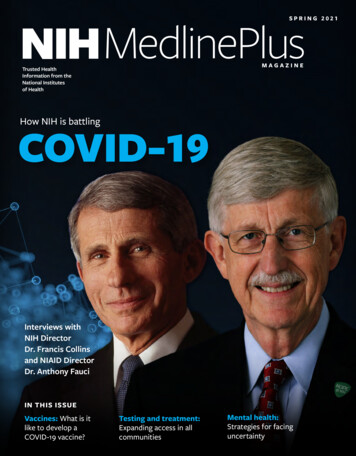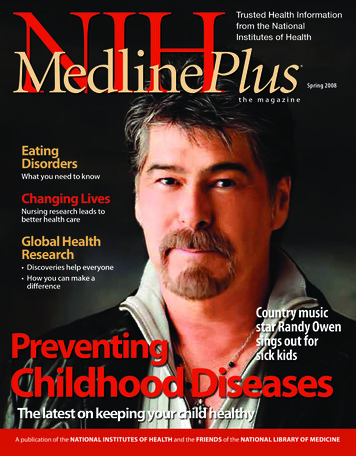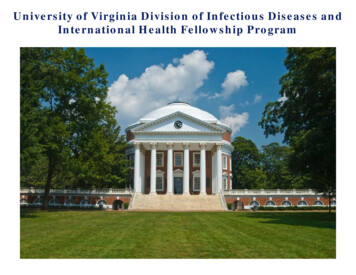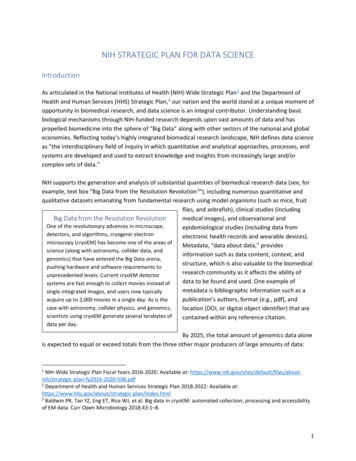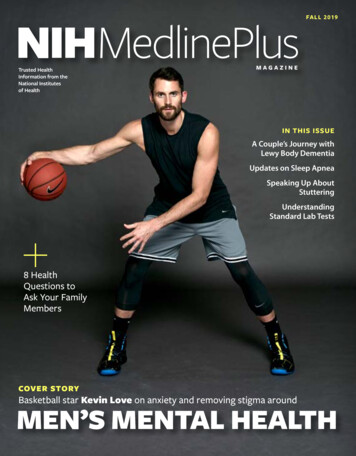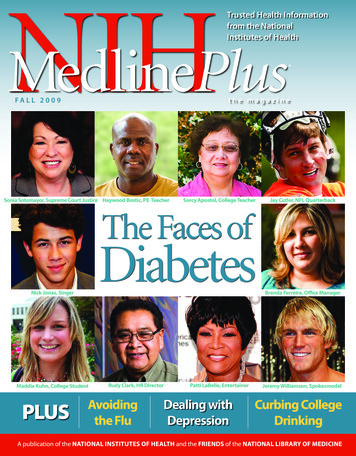
Transcription
MedlinePlusNIHTrusted Health Informationfrom the NationalInstitutes of HealthFA L L 2 0 0 9 the magazineSonia Sotomayor, Supreme Court Justice Haywood Bostic, PE TeacherSorcy Apostol, College TeacherJay Cutler, NFL QuarterbackThe Faces ofDiabetesNick Jonas, SingerMaddie Kuhn, College StudentPLUSRudy Clark, HR DirectorAvoidingthe FluPatti LaBelle, EntertainerDealing withDepressionBrenda Ferreira, Office ManagerJeremy Williamson, SpokesmodelCurbing CollegeDrinkingA publication of the National Institutes of Health and the Friends of the National Library of Medicine
FRIENDS OF THE NATIONAL LIBRARY OF MEDICINENIH Loses a FriendDonald West King, M.D.FNLM ChairmanLet Us HearFrom You!We want your feedback on themagazine, ideas for future issues, as wellas questions and suggestions. E-mail yourletters to Managing Editor Selby Bateman(selby.bateman@vitality.com) orsend mail to Editor, NIH MedlinePlusMagazine, P.O. Box 18427, Greensboro, NC27419-8427. We will feature some of yourletters in upcoming issues.Help Out for Health: Be a FriendYou can be part of the Friends’ mission to help educate thepublic and the health and corporate communities about NIH’smany vital research initiatives.If you or your company can help to support and expand thepublication and distribution of NIH MedlinePlus magazine, thousands and thousands more people will gain valuable, free accessto the world’s best online medical library, www.medlineplus.gov.For more information, please visit www.fnlm.org or call(202) 719-8094. Or, write to FNLM, 2801 M Street NW,Washington, DC 20007.The FNLM is classified as a 501(c)(3) nonprofit organizationfor federal tax purposes. Web site: www.fnlm.orgStay Connected!Keep up with MedlinePlusand the National Libraryof Medicine (NLM) forthe most reliable, useful,and understandablehealth information. Join usonline, and please spreadthe word!MedlinePlus and NLM on Web site: medlineplus.govFollow us on@medlineplus4youPhoto: NIHPhoto: NLMSince our last issue, two champions of American health care have died: Senator EdwardM. Kennedy (see page 26) and Ruth L. Kirschstein, M.D. They dedicated their lives toimproving people’s health.Dr. Kirschstein was an outstanding scientist, mentor, and health administrator. Sheand her husband, Alan Rabson, M.D., now a deputy director at the National Cancer Institute,came to NIH in the 1950s to work as pathology researchers. They made a tremendous team,providing NIH with outstandingcompetence, integrity, and vision for over 50years. She held the most importantleadership posts in recent NIH history.As director of the National Institute ofGeneral Medical Sciences from 1974 to 1993,Dr. Kirschstein was the first woman institutedirector at the National Institutes of Health.Then she became director of the newlyestablished Office of Research on Women’sHealth, during which time she served for acritical period as Acting Director of the NIH.Despite poor health, she kept working untilthe week before she died.For more about Dr. Kirschstein and otherremarkable women physicians, please seethe wonderful NLM exhibit “Changing theFace of Medicine” at:Dr. Ruth Kirschstein is featured inthe Library’s “Changing the Facewww.nlm.nih.gov/changingthefaceofmedicine/.of Medicine” exhibit about womenmedical pioneers and leaders.Sincerely,The Library created the exhibit toDonald West King, M.D., Chairmanhelp inspire future generations ofFriends of the National Library of Medicinewomen doctors.
MedlinePlusNIH the magazinecontentsVolume 4 Number 4 Fall 2009NATIONAL LIBRARY OF MEDICINEat the NATIONAL INSTITUTES OF HEALTH8600 Rockville Pike Bethesda, MD 20894www.nlm.nih.govwww.medlineplus.govDonald A.B. Lindberg, M.D.Director, NLMBetsy L. Humphreys, M.L.S., A.H.I.P.Deputy Director, NLMKathleen CravediDirector, Office of Communicationsand Public Liaison, NLMElliot Siegel, Ph.D.Associate Director for Health InformationPrograms Development, NLMNaomi Miller, M.L.S.Manager of Consumer Health Information, NLMPatricia CarsonSpecial Assistant to the Director, NLMChristopher KloseMagazine CoordinatorPeter ReineckeStrategic Advisor, NLMIf you are interested in providing a sponsorship or othercharitable donation to support and extend the reach of this publication,please contactFriends of the NLM202-719-8094IFC From the FNLM2 F rom the Director:Francis S. Collins,M.D.5 Avoiding the Flu8 F acing Diabetes:What You Need toKnow16 “ Depression CanDisguise Itself.”20 H ealthy HolidayMeals22 G et Tested forGlaucoma!2801 M Street NW, Washington, DC 20007FNLM Officers and Advisory BoardDonald West King, M.D., Chairman Frank Bonner, M.D., PresidentJoseph Perpich, M.D., Vice President Barbara Redman, Ph.D., SecretaryWilliam Gardner, M.D., TreasurerSelby Bateman, Managing EditorJan McLean, Creative DirectorTraci Marsh, Production DirectorNIH MedlinePlus, the Magazine is published byVitality Communications407 Norwalk St.Greensboro, NC 27407(336) 547-897024 C urbing CollegeDrinking8Diabetes is growing at epidemicrates. Here’s what you can do.26 I n Tribute: SenatorEdward M. Kennedy27 Healthlines29 Info to Know16Seek help for depression—the firststep in getting relief.William G. Moore, PresidentPat Blake, ControllerArticles in this publication are written by professional journalists.All scientific and medical information is reviewed for accuracy by representativesof the National Institutes of Health. However, personal decisions regarding health,finance, exercise, and other matters should be made only after consultation with thereader’s physician or professional advisor. Opinions expressed herein are notnecessarily those of the National Library of Medicine.5Get vaccinated for seasonal andH1N1 flu. Stay healthy this winter.Photos: (top of page) CDC;(center) Getty Images;(bottom) Mayada Akii, M.D.;(cover) NIDDK, AP, Christopher Klose,Jeremy Williamsonwww.medlineplus.gov Fall 2009 1
New NIH Director Dr. Francis Collins onMedical ResearchThat BenefitsEveryone’s HealthAs Director of the National Institutes ofHealth, Dr. Francis S. Collins, M.D., Ph.D.,oversees more than 18,000 employees. Withthe support of the American people, the NIHannually invests over 28 billion in medical research.More than 83 percent of the NIH’s funding is awardedthrough almost 50,000 competitive grants to morethan 325,000 researchers at over 3,000universities, medical schools, and otherresearch institutions in every state andaround the world. About 10 percent of theNIH’s budget supports projects conductedby nearly 6,000 scientists in its ownlaboratories, most of which are on theNIH campus in Bethesda, Md.also happened to be a geneticist brought some patients for usto interact with and interview. We met a young man with sicklecell disease, a child with Down syndrome, and others—allexamples of how one small glitch in the genome can have greatimpact. That helped me to see how scientific investigation ofthe most basic aspects of life, of DNA, RNA, and protein, couldhave fundamental consequences for human beings. If I wasWhat is your primary goal for NIHas Director?going to be in medicine, I wouldn’t be satisfied leaving thoseproblems to someone else to figure out. That was 35 years ago.“Science is not a 100-yard dash. It’s amarathon. Our goal is to advancebiomedical research in new, innovativeways that will benefit everyone’s health.”Our most basic mission at NIH is to extend the knowledge of thenature and behavior of living systems. Our most fundamentalhuman goal is to reduce the burdens of illness and disability onpeople and their families.What inspired you to a life of research?During my first year as a medical student, a pediatrician who2 Fall 2009 NIH MedlinePlus— NIH Director Dr. Francis CollinsCould you describe the state of NIH research today?Investigator-initiated research has been the bedrock of NIHbreakthroughs over the decades. Today, the number and variety ofresearch activities and the depth of molecular understanding ofhow life works are breathtaking. Such basic information is criticalto understanding what goes wrong when disease strikes.
NIH Director, Dr. Francis S. Collins,was Director of the NIH’s NationalHuman Genome Research Institutefrom 1993 to 2008. The U.S. Senateunanimously confirmed Dr. Collinsas the new Director.NIH is currently supporting, down to the individualresearch grant. We believe this is transparency for thebenefit of all.What areas will you be emphasizing forNIH over the next few years?Photo: NIHWe see five fairly broad opportunities that holdgreat promise.New Technologies—Today’s high-throughputtechnologies can help to break down the boundarieslimiting our understanding of disease; for example,that what we thought we were doing to study cancerturns out to tell us something crucial about heartdisease. Or that investigating a rare disorder affectingonly a few hundred people has profound implicationsfor millions of people with high blood pressure orasthma. The notion that medical research could becompartmentalized is turning out to be wrong. Thereis all the more reason to work together to understandscientifically how we’re connected.Genomics is one of those technologies that is changing ourunderstanding of brain cancer, for instance. In a new pilot project,it is being used to look at the genetic script to identify and catalogthe glitches that make a good cell go bad. This can be expanded toother cancers as well, changing forever what cancer is all aboutand how to prevent and treat it.Discovery into Practice—I am particularly passionate abouttranslating basic discoveries about the causes of disease intoeffective treatments, whether the disease is common or rare. Weneed to bridge the gap between discovery and development asquickly as possible.Healthcare Reform—We can put science to work to betterunderstand how to rein in costs and improve outcomes. Forinstance, in the area of comparative effectiveness, NIH has beenstudying various clinical problems to see which treatmentapproaches are most effective and thereby less costly. In the samevein, various payment incentive models could be compared in aThere is also “big science”—projects like the Human GenomeProject and others—that enables researchers to get answers morequickly, and use their resources more efficiently. The challenge isto decide how to support everything, with an emphasis onreleasing the data from the big projects immediately, so thateveryone can begin to take advantage of those discoveries.How is NIH sharing what it learns?President Obama continues to emphasize the importance oftransparency, open government, public engagement, andcollaboration. NIH uses a wide variety of programs andtechniques to make as much information as widely available aspossible. It’s a matter of public trust.We are committed to getting out the latest research aboutprevention, diagnosis, and treatment. One of our latestadvances is a long-anticipated upgrade to the popular CRISP(Computer Retrieval of Information on Scientific Projects) Website. Through the upgrade, called REPORT (Research PortfolioOnline Reporting Tool http://report.nih.gov), anyone can see whatwww.medlineplus.gov Fall 2009 3
Photo: U.S. Department of Health and Human ServicesFrancis S. Collins, M.D. (left), was sworn in as the16th Director of the National Institutes of Health byKatherine Sebelius (right), Secretary of the Department ofHealth and Human Services, on August 17. With Dr. Collinsis his wife, Diane L. Baker (center).research environment to answer some of the questions floatingout there.We also must invest more in learning how drugs workdifferently in different people, and the personalized medicineagenda needs to be moved forward. We need to better understandthe causes of health disparities and what can be done to dispelthem. This is going to require social and behavioral research toclarify how people absorb information and actually alter their ownhealth behaviors.Global Health Focus—Partnering with the World HealthOrganization, the Gates Foundation, and other philanthropies, theopportunity has never been better for NIH to apply what we knowtherapeutically around the world. We have come quite a distancein understanding many of the diseases common to the developingworld, but much more remains to be accomplished.Supporting Scientists—We could do everything possible tocome up with new ideas and new technologies, but if we don’thave the people to do the research, then we’re going to continue tolose out in terms of our standing in the world. Tomorrow’sresearchers must see that it is possible to have careers that supportinnovation and creativity. So we need to focus on supporting thescientific community the best way we can. At the same time, weneed to make the case for the value of medical research, and usethe resources we are given by the American taxpayer creatively.One particularly relevant project here is the NIH Roadmap forMedical Research, launched in September, 2004, to transform4 Fall 2009 NIH MedlinePlusbiomedical research by overcoming specific hurdles or fillingdefined knowledge gaps.Do you have the funding to do all of this?Under the American Recovery and Reinvestment Act, NIH hasreceived 10 billion in stimulus funding, which represents anextraordinary opportunity. In addition, we have been givenanother 400 million for comparative effectiveness research.What impact will this have, do you think?Every grant we give out creates about seven jobs, and everyresearch dollar generates more than two dollars in goods andservices in less than a year. In terms of stimulating the economy,NIH is near the top of the list. But science is not a 100-yard dash.It’s a marathon. Our goal is to advance biomedical research innew, innovative ways that will benefit everyone’s health.Watch Videos of Dr. CollinsTo see online videos of Dr. Collins speakingabout health and the NIH, appearing on TheColbert Report, and related appearances, visitwww.nih.gov/about/director/ and look underthe “Multimedia” heading.
Avoiding the FluEach year, from late fall through early spring, there are outbreaks of seasonal flu. In additionto this year’s seasonal flu, there is the 2009 H1N1 flu virus. This is causing a more dangerous flu season.More people than usual are getting sick, being hospitalized, and dying than during a typical flu season.Vaccines for seasonal flu and 2009 H1N1 flu are available to help people prevent coming down with them.Here’s what you need to know to help avoid getting and passing on the flu.Influenza (Seasonal)Photo: James Gathany, Centers for Disease Control and PreventionThe flu is a contagious respiratory illness caused byinfluenza viruses. It causes mild to severe illness and cansometimes lead to death. The best way to prevent seasonalflu is by getting a flu shot each year. In the U.S. each yearon average,77 5 to 20 percent of the population gets the flu,77 more than 200,000 people are hospitalized fromflu-related complications, and77 about 36,000 people die from flu-related causes.Older people, young children, and people with asthma,diabetes, heart disease, and other conditions are at highrisk for serious flu complications.2009 H1N1 InfluenzaChildren from six months of age and young people up to 24 years of ageare particularly at risk this year from the 2009 H1N1 flu. They are amongthe groups being given priority to receive the H1N1 vaccine (either shotor mist).The 2009 H1N1 flu is caused by a different virus thanthe seasonal flu. Its symptoms are similar to those ofseasonal flu, including fever, cough, sore throat, bodyaches, headache, chills, and fatigue. But those most at riskfor 2009 H1N1 are different from those most vulnerableto the seasonal flu. Although sometimes incorrectly called“swine” flu, 2009 H1N1 is not the 1976 swine flu virus.People vaccinated against swine flu in 1976 should still getthe 2009 H1N1 vaccine.H1N1 Flu: Who Should Be Vaccinated FirstThe Centers for Disease Control and Prevention(CDC) is urging everyone to get both the seasonaland H1N1 vaccines. The 2009 H1N1 vaccine, either byinjection or nasal spray, does not replace the seasonal flu shot.It is intended to be used with it.People most at risk from 2009 H1N1 flu and being givenpriority to receive the first doses of H1N1 flu vaccine include:77 Pregnant women;77 People caring for infants six months or younger, becauseyounger infants are at higher risk of influenza-relatedcomplications and cannot be vaccinated;77 Healthcare and emergency medical services personnel,who can be a potential source of infection forvulnerable patients;77 Everyone from 6 months through 24 years of age; and77 People aged 25 through 64 years with asthma, diabetes,heart disease, and other health conditions associatedwith high risk from flu complications.—Centers for Disease Control and Prevention (CDC)www.medlineplus.gov Fall 2009 5
2009 H1N1Flu VaccineFacts2Pregnant women should definitely get the 2009H1N1 flu vaccine.3You need only one dose of the H1N1 vaccine.4Flu shots are vaccines from dead or inactivatedforms of the flu virus.5Healthy people are in danger from the new 2009H1N1 virus, and they should get vaccinated.Photo: iStockChanges to a pregnant woman’s immune system can make hermore sensitive to the flu and result in serious complications if sheis infected with H1N1. If you are pregnant, you should getvaccinated against H1N1 as soon as possible. Your vaccination canpotentially protect your unborn child from infection.The Centers for Disease Control and Prevention (CDC)and the National Institute of Allergy and InfectiousDiseases (NIAID) offer these flu facts to help theAmerican people understand the safety and effectiveness of theH1N1 flu vaccine.1The 2009 H1N1 flu vaccine is safe and well tested.Clinical trials conducted by the National Institutes ofHealth and the vaccine manufacturers have shown that the newH1N1 vaccine is both safe and effective. The FDA has licensed it.There have been no safety shortcuts.It is produced exactly the same way the seasonal flu vaccine isproduced every year. It is simply a new virus strain. In fact, hadH1N1 struck this country earlier than this spring, the H1N1 strainprobably would have been included as part of this year’s seasonalflu shot.Millions of Americans get the seasonal flu vaccine each yearwithout any problems. Still, since some Americans have concernsabout “new” vaccines, the NIH and the vaccine manufacturershave conducted more thorough tests on the H1N1 vaccine thanthey do on other flu vaccines. There have been no red flags fromthese clinical trials.The risk of the flu, especially for pregnant women, children, andpeople with underlying health conditions, is higher than any riskthat might come from the H1N1 vaccine.6 Fall 2009 NIH MedlinePlusGood news from our clinical trials being run by theNational Institutes of Health and the flu vaccine manufacturers:The H1N1 vaccine is a really good match with the H1N1 viruscurrently circulating across the country. Healthy adults andchildren 10 and older will need only one dose of vaccine.It’s also fine to get the seasonal flu shot and the H1N1 shot atthe same time. But if you get the nasal spray form of the vaccine,you need to wait three to four weeks before getting another nasalspray vaccine.Both the seasonal and 2009 H1N1 flu shots are vaccines thatcontain killed/inactivated influenza virus. The nasal spray H1N1vaccine contains a live, but weakened, form of the virus that doesnot cause flu illness.Both healthy people and people with underlying healthconditions, such as asthma and diabetes and other chronicdiseases, are at risk from the 2009 H1N1 flu. In CDC studies,about 70 percent of people who have been hospitalized with this2009 H1N1 virus have had one or more medical conditions thatplace them at “high risk” of serious seasonal flu-relatedcomplications. Thirty percent of those hospitalized werepreviously healthy.The 2009 H1N1 flu has especially affected young people ages5 to 24. A recent study in the New England Journal of Medicine of272 hospitalized H1N1 patients showed that 60 percent of thechildren who were hospitalized had an underlying condition.The remaining 40 percent had no underlying condition.
NIH Flu Researchto ResultsScientists at the National Institute of Allergy and InfectiousDiseases (NIAID) and researchers supported by NIAID worldwideare collaborating to to prevent, diagnose, and treat seasonal andpandemic influenza, including 2009 H1N1 flu.Photo: iStockClinical Trials for FluWhat You Can Doto Stop the FluTo reduce chances of getting or spreading the flu:77Cover nose and mouth with a tissue when youcough or sneeze. Dispose of the tissue afteruse.77Wash hands often with soap and water oralcohol-based hand cleaners after coughingor sneezing.77Avoid touching your eyes, nose, or mouth.77Avoid close contact with sick people.77Stay home from work or school if you are sick.NIH has started several clinical trials to determine whatdosages of the 2009 H1N1 influenza vaccine can best protecthealthy and high-risk groups, especially pregnant women,children, young people, and those with asthma.“These trials are being conducted through our longstandingvaccine clinical trials infrastructure, which includes the Vaccineand Treatment Evaluation Units,” says Anthony S. Fauci, M.D.,NIAID Director. “This is a network of medical centers that canquickly test vaccines in response to emerging threats to publichealth, like 2009 H1N1 influenza.”For more of what you need to know about the flu,go to the NIAID Web site (www.niaid.nih.gov) and to http://ClinicalTrials.gov.Flu News, Information, and ResourcesTo find a flu shot location near or.htmlTo find state, regional, and national flu nters for Disease Control and Prevention (CDC)To Find Out MoreMedlinePlus:n www.nlm.nih.gov/medlineplus/flu.htmln tional Institute of Allergy and Infectious Diseases:n www.niaid.nih.gov/topics/FluU.S. Department of Health and Human Services:n http://flu.govwww.medlineplus.gov Fall 2009 7
Facing Diabetes:What You Need to KnowNovember is National Diabetes Awareness Month—The National Institutes of Health, with theCenters for Disease Control and the American Diabetes Association, have launched new educationalcampaigns to alert all Americans to the dangers of diabetes. The following special section covers whatyou need to know to protect you and your loved ones.FASTFACTSPhotos: AP77There are three main types of diabetes:type 1, usually first diagnosed inchildren, teens, or young adults; type2, once called adult-onset and nowamong the fastest-growing conditionsin Americans of all ages; and gestationaldiabetes, occurring in some womenduring pregnancy.The Faces of DiabetesDiabetes strikes millions of Americans, young and old, rich and poor,famous or not. Here are four role models who are successfully controllingtheir disease. You will find stories about others with diabetes in this section.(Clockwise from top left)Nick Jonas: Teen singing sensation Nick Jonas, leader of the JonasBrothers band, was diagnosed with type 1 diabetes in 2005. A role model forother teens with diabetes and a champion of good diabetes management, hespeaks out for more research.Jay Cutler: Diagnosed with type 1 diabetes in 2008, the Chicago Bearsquarterback wears an insulin pump to help control his diabetes. Off thegridiron, he raises funds for children with diabetes.Sonia Sotomayor: The new U.S. Supreme Court Justice has had type 1diabetes since childhood. With the help of her mother, a registered nurse, shehas always made sure to control her disease.Patti LaBelle: It was only after collapsing on stage during a performancethat the popular songstress learned she had type 2 diabetes. Since then, sheexercises regularly to help control it and has authored healthy-eatingcookbooks.8 Fall 2009 NIH MedlinePlus77With diabetes, the body does notproduce or properly use insulin, thehormone that converts sugar, starches,and other foods into the energy fordaily living.77Diabetes can lead to many complications.The disease can severely damage theheart, kidneys, eyes, skin, legs and feet,nerves, and teeth and gums. It can resultin premature death.7723.6 million Americans havediabetes—7.8 percent of the U.S.population. Nearly one in four of thosedon’t know they have it.77About 57 million adults aged 20 andolder have pre-diabetes. This is acondition where blood glucose (sugar)levels are higher than normal but nothigh enough to be called diabetes.Pre-diabetes puts you at risk for type 2diabetes and cardiovascular disease.
Diabetes Stories“ Control Your“ Stop DiabetesDiabetes. For Life” Now!”For information about “ControlYour Diabetes. For Life” campaign,visit www.YourDiabetesInfo.org orcall toll-free 1-888-693-NDEP (6337).This month, the AmericanDiabetes Association islaunching an educationalcampaign, “Stop Diabetes,” to persuademore Americans to understand and takeaction to prevent and treat the disease.The Association is spreading its messageto families, volunteers, businesses, thescientific and medical communities, andthe general public, notes AmericanDiabetes Association Chair of the BoardGeorge J. Huntley.“The goal is to motivate one million newpeople to take action to stop diabetes in thenext 12 months,” he says, “and to grow thatnumber to three million people in threeyears. This will take steadfast courage,unflinching commitment, and patience.”Diabetes has reached crisis proportions.It affects all Americans, either directly orindirectly. The Association is to recruitpeople from all walks of life to:77 Learn more about diabetes77 Raise awareness among their families,friends, and communities77 Promote more diabetes research77 Volunteer to help spread the message ofgood health“The Stop Diabetes movement is sayingthat we can no longer dismiss or ignore thisdisease,” says Huntley. “It is time to dowhatever it takes to confront and stop it.”To find out more about Stop Diabetes,visit stopdiabetes.com or call theAmerican Diabetes Association’s toll-freenumber, 1-800-DIABETES.Tips for Seniors at Riskfor Type 2 DiabetesLifestyle changes that lead to weightloss—such as making healthy food choicesand getting more exercise—are effectivein helping to reduce the developmentof diabetes. These lifestyle changes areespecially effective in people aged 60and older, who can reduce their risk ofdeveloping type 2 diabetes by 50 percentover 10 years.—NIDDKPhoto: Christopher KloseThe ”Control Your Diabetes. For Life”educational campaign kicks off thismonth. The National DiabetesEducation Program (NDEP) developed thecampaign, jointly sponsored by theNational Institutes of Health (NIH) and theCenters for Disease Control and Prevention(CDC), with the support of more than 200partner organizations.The message is: People with diabeteswho keep their blood glucose (sugar) asclose to normal as possible soon after theyare diagnosed have fewer problems withtheir eyes, nerves, and kidneys. They alsohave fewer heart attacks later in life.Glucose levels are measured by a bloodtest—called the A1C test—that averages aperson’s glucose range over the past two tothree months.“This is very important for people withdiabetes to know,” says Griffin P. Rodgers,M.D., Director of the National Institute ofDiabetes and Digestive and KidneyDiseases (NIDDK). “Diabetes is a seriousdisease. Managing it is not easy, but thebenefits are worth the effort. Keeping yourblood sugar in a target range that is safefor you reduces the chances of serioushealth problems later on.”“Everyone’s target range is different, sotalk with your healthcare team about thebest target goal for you,” says NDEPDirector JoanneGallivan, M.S., R.D.“Also, controlling bloodpressure andcholesterol can loweryour risk for heartattacks and otherdiabetescomplications.”Maddie Kuhn, 19Washington, DCType 1“ Diabetes has instantconsequences.”Diagnosed with type 1 diabetes in the third grade,Madeleine “Maddie” Kuhn doesn’t let the disease inhibit her.The American University sophomore belongs to a sorority,plays doubles on the tennis team, co-produces a popularcampus TV talk show, does public relations for anenvironmental group, helps her local Model United Nationschapter–and keeps up with her courses.Diabetes is not something that should get you down,although it is hard when you’re a kid.My parents, both doctors, saw the signs and admitted mefor early treatment and training in managing the disease. Ithought I’d just get better. But after two weeks of injectingmyself with insulin, I didn’t want to do it any more.You never grow out of diabetes. Insulin pumps make iteasier. But you can’t anticipate what your body’s going to do, soyou have to constantly monitor. The more you monitor, theeasier it gets. If my blood sugar goes low in class, for instance, Ihave to snack even though it still embarrasses me a little.Diabetes becomes a part of you. If they find a cure, whowould I be without it?Diabetes makes me a strong person. There are times whenyou want to chuck it all. But diabetes has instant consequences.You learn to be responsible pretty quickly, or else.My advice for others with diabetes is to be aware of theircondition; to see it as a part of life than can help to make youstronger. There are also opportunities with diabetes, so beaware and take advantage of them.www.medlineplus.gov Fall 2009 9
“ Small Steps, Big Rewards”:Preventing Type 2 DiabetesThe good news is type 2 diabetes can bedelayed and possibly prevented by:77 losing a modest amount of weight77 exercising 30 minutes a day five times aweek77 The NDEP developed an education77 choosing healthy foods and reducingcampaign, Small Steps, Big Rewards:calories and fat in the dietPreventType 2 Diabetes, to helpThese are the plain facts in “Small Steps.peopleathigh risk take the necessaryBig Rewards: Prevent Type 2 Diabetes,” ansteps to prevent the disease (www.education campaign of the Nationalndep.nih.gov). Over 200 pri
sands and thousands more people will gain valuable, free access to the world's best online medical library, www.medlineplus.gov. For more information, please visit www.fnlm.org or call (202) 719-8094. Or, write to FNLM, 2801 M Street NW, Washington, DC 20007. The FNLM is classified as a 501(c)(3) nonprofit organization for federal tax purposes.

